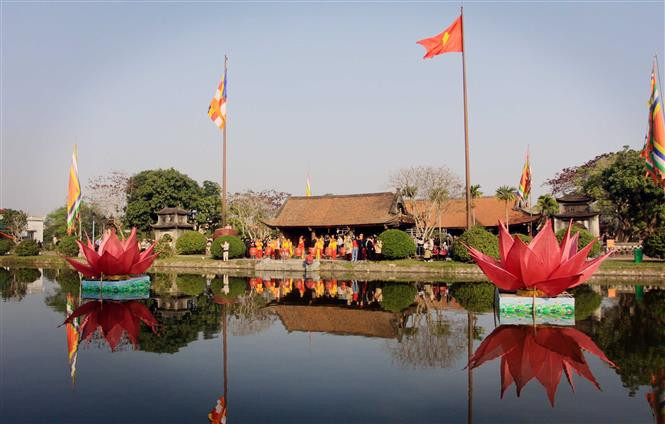Keo Pagoda – A Masterpiece of 17th-Century Le Dynasty Architecture
Keo Pagoda, a renowned Buddhist monastery distinguished by its exquisite 17th-century Le Dynasty architecture, is located in Duy Nhat Commune, Vu Thu District, Thai Binh Province. Each year, the pagoda hosts two major festivals:
• The Autumn Festival (from the 10th to the 20th day of the ninth lunar month)
• The Spring Festival (on the 4th day of the first lunar month)
The Autumn Festival commemorates both the birth anniversary and the centenary of Zen Master Duong Khong Lo, an eminent physician, Great Master, and National Preceptor of the Ly Dynasty. Meanwhile, the Spring Festival is deeply rooted in the region’s wet rice agriculture traditions, making it one of the most representative agricultural festivals in the Red River Delta.
On the fourth day of Tet (Lunar New Year), thousands of pilgrims from across the country gather at Keo Pagoda. Amidst the festive spring atmosphere, people appear more joyous and vibrant, praying for good fortune, favorable weather, and abundant harvests of rice and crops. What makes the Keo Pagoda Spring Festival particularly special is its diverse array of folk games and competitions, closely tied to the daily lives of local farmers. These include rice cooking contests, duck-catching games, and chess tournaments, among others.
The Traditional Rice Cooking Competition
In the past, Keo Village was divided into eight communal wards :
• Four Eastern Wards: Dong Nhat, Dong Nhi, Dai Huu, and Vong Dong
• Four Western Wards: Doai Nhat, Vong Doai, Hoang Quy, and Duong Thinh
Preparations for the rice cooking competition were meticulously planned well in advance. Each ward selected skilled participants and carefully curated the finest agricultural ingredients, such as glutinous rice and mung beans. Additionally, they sought out mature bamboo slats, which were dried over the kitchen rafters for an entire year. These bamboo strips were essential for fire-starting, a key element of the competition.
On the festival day, crowds gathered in front of Ong Ho Pagoda to witness the event. The wards selected young, strong, and agile men to participate in a four-lap race around the temple’s lake, each carrying a water jar. Their objective was to fetch water for their ward, while others in the team began rinsing rice, washing beans, and pounding flour.
As soon as the racers returned with water, the fire-starting process commenced. Two participants from each ward vigorously rubbed aged bamboo strips together over a pile of soaked chinaberry tree tinder. The intense friction generated heat, eventually igniting a flame—a moment met with cheers and applause from the audience. The first ward to successfully produce fire earned bonus points.
Once the fires were lit, participants quickly moved on to steaming sticky rice, cooking plain rice, and preparing sweet porridge (chè). They had to work efficiently yet precisely, avoiding spills or breakages. The atmosphere became electrifying, with the pounding of drums and the shouts of enthusiastic spectators filling the air.
At the designated time limit, the dishes were evaluated based on consistency, aroma, and taste:
• Sticky rice had to be soft and uniform
• Plain rice needed to be fragrant, well-cooked, and free from undercooked or burnt grains
• Sweet porridge had to achieve a rich, balanced sweetness
The results were determined based on timing, quality, and presentation.
The Duck-Catching Competition – A Display of Strength and Agility
The duck-catching contest was another thrilling highlight, drawing strong, energetic young men eager to showcase their physical prowess. Held on Nam Lake, just in front of the pagoda, pre-selected ducks with exceptional swimming and diving abilities were released into the water.
Participants had to swim and dive skillfully to capture the ducks. However, as soon as they neared their target, the ducks would swiftly dive underwater, disappearing from sight. The spectators roared with laughter and cheered on the competitors, making the event a lively and joyous spectacle.

!["[KTMH] Trailer | WHAT TO DO TO MAKE SUMMER HOLIDAYS MORE MEANINGFUL?"](https://i3.ytimg.com/vi/s0VUGa1v6uw/maxresdefault.jpg)